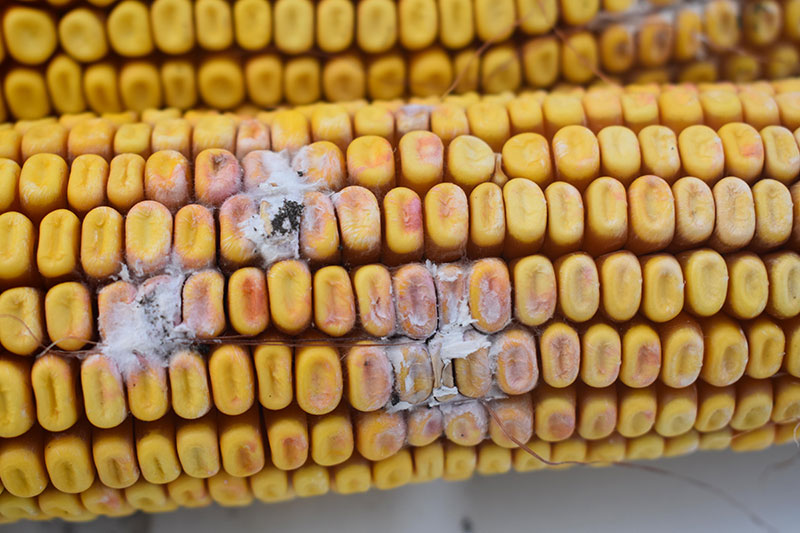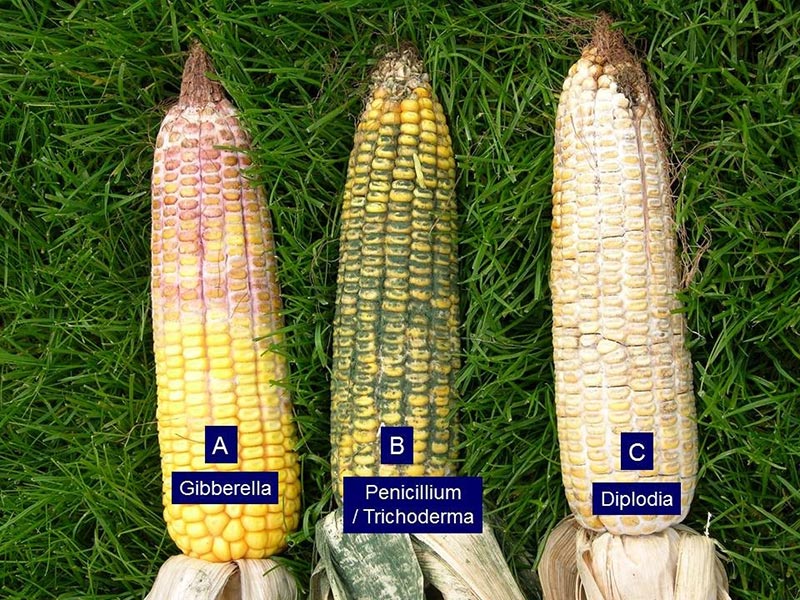Ear Moulds in Corn

Not every growing season brings a high risk of ear moulds in corn, but it certainly can be an issue every once in a while. It is crucial to scout for ear moulds of all kinds every fall to determine risk and harvest order. Upright ears, tight husks, high humidity, precipitation, insect feeding and very slow drying conditions are all factors that contribute to mould development and spread. Severity and mould types will vary, so scouting is recommended, regardless of environmental potential.
There are several types of mould that can grow on corn, and three that are typical in Manitoba:
- Gibberella Ear Rot
- Fusarium Ear Rot
- Diplodia Ear Rot
Gibberella ear rot
Gibberella ear rot occurs via an infection of the fungus Gibberella zeae, the same fungus that causes Fusarium head blight in cereals and overwinters on corn and wheat residues. Infection occurs when spores are splashed by rain or carried by wind, and settle on corn silks or the base of the ear. Silks are vulnerable to infection for the first week after emerging, during the pollination period of corn. Further in the season, during grain fill, ear rot is known to start becoming visible and worsening when conditions are cool and wet at this time.
Gibberella ear rot is characterized by a pink or red colouring of the mould, most commonly at the ear tip. High amounts of mould can make the ear bond to the husk and become hard to pull away from the ear. It can produce the toxins Deoxynivalenol (vomitoxin or DON), Zearalenone (ZEN) and T-2 toxin.
Fusarium ear rot
Fusarium ear rot infections peak when areas are highly affected by grain-feeding insects, such as European corn borer or corn earworm, coupled with warm and wet conditions prior to harvest. Identification is different from Gibberella ear rot in that it occurs in individual kernels or in patches on the ear, based on insect feeding. Infected kernels may appear white to pink-coloured, which is the visible fungal growth. Some affected kernels may be a tan to brown colour. In the event that the pathogen is growing underneath the seed coat, the kernels may show a white starburst or streaking pattern.
There are three common fungi species that cause Fusarium ear rot, but only Fusarium verticillioides and Fusarium proliferatum produce fumonisins, which can be toxic to livestock. If infections are visible, species testing needs to be performed in a laboratory and Fusarium contamination can be determined at that point.
Diplodia ear rot
Diplodia ear rot is less common in Manitoba. It may be visible in continuous corn fields or fields with short rotation and that are managed by reduced tillage practices. Infected ears will have mould growth starting at the base of the ear that will begin as a white to gray colour and will be growing both between and on the kernels. With further maturation of the fungus, the mould could turn to a darker gray to gray-brown colour.
Infection occurs via spores being splashed onto developing ears. Spores infect the ear shank during silking, then move into the ear shank to the cob and can progress outward via the kernels, then becoming visible in the mouldy appearance of the ear. Due to infection timing, corn ears are most susceptible to Diplodia infection around silking and the threat becomes less as the crop matures.
Corn yield can be affected simply by any three of these fungus-related moulds taking over several kernels and spreading throughout a cob. Affected kernels likely disintegrate or pass right through the combine at harvest. Kernels can be successfully harvested but cracked or damaged. Finally, harvest may be a total success, only to learn there are high mycotoxin levels (most concerning being vomitoxin or DON – Deoxynivalenol) in the grain, deeming it unsaleable. Husky Grain states that they buy grain with only a maximum level of 1 ppm of vomitoxin.
If a producer is unsure of their risk this year, the first step will be to scout their corn and identify any moulds occurring. Vomitoxins are primarily produced by Gibberella or Fusarium ear moulds, so if either of these are identified or suspected, the risk is increased. Mycotoxins cannot be identified visually, so a representative sample needs to be sent for analysis, if suspected. Samples in Manitoba can be sent locally to Central Testing Laboratory Ltd. in Winnipeg.
Figure 1. Gibberella Ear Mould
Figure 2. Fusarium Ear Rot
Figure 3. (L to R) Gibberella, Penicillium/Trichoderma and Diplodia Ear Rot. Photo Credit: Ontario Ministry of Agriculture, Food and Rural Affairs.
Fields with high incidence of moulds of any kind should be harvested first, where possible. Affected kernels should be harvested and dried as soon as possible to minimize spread and further degradation. High temperature drying (anything above 30oC) will stop mould growth and mycotoxin production but will not reduce mycotoxins already present. See OMAFRA’s article on Harvest Tips for Mouldy Corn for more information that may benefit corn harvest this year.
Corn Ear Mould Identification Article – Ontario Ministry of Agriculture, Food and Rural Affairs
Field Drydown
We are often quite fortunate with drying weather for natural grain dry down in the field. Manitoba Agriculture has an article indicating speed of natural drying in the field, in October and November. It also touches on artificial low temperature versus high temperature drying, estimating drying costs, in-storage cooling and much more. It is a great reference to bookmark.
More great articles on field dry down, natural air drying and storage of grain corn:
- Successful Farming on 8 tips for long-term grain storage
- Ken Hellevang, NDSU extension engineer – Grain Drying and Storage – Corn and Soybean
- Bob Nielsen, Agronomy Department, Purdue University – Field Drydown of Mature Corn Grain
- Manitoba Agriculture – Harvesting Grain Corn in Late Fall



